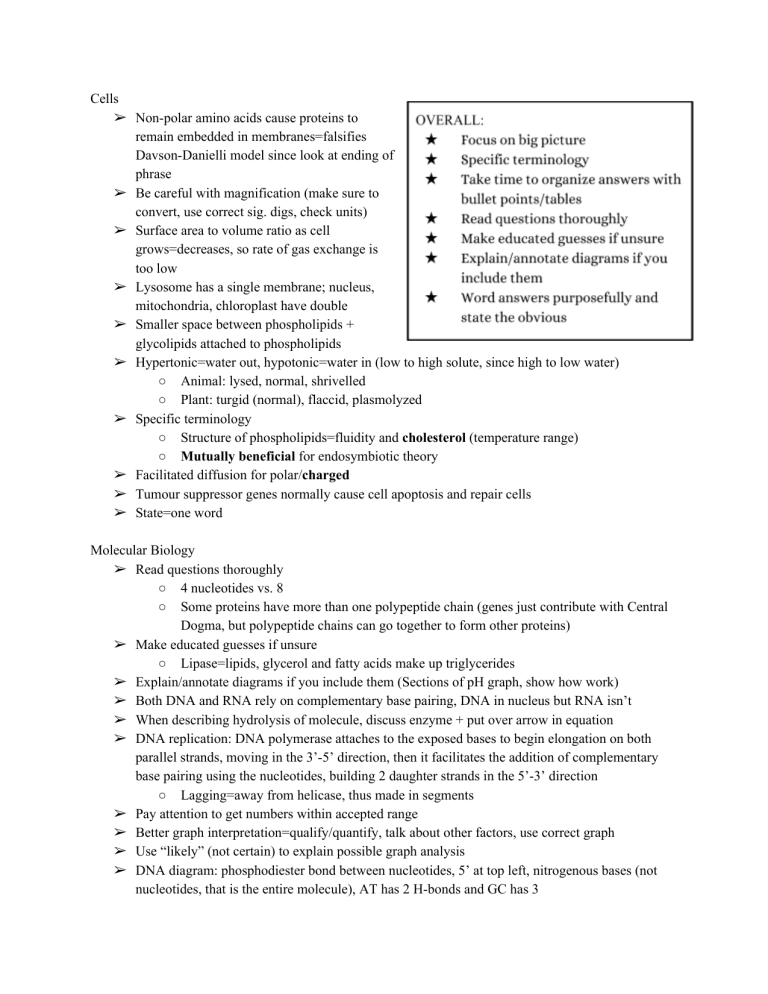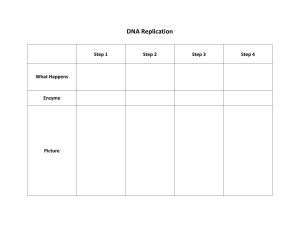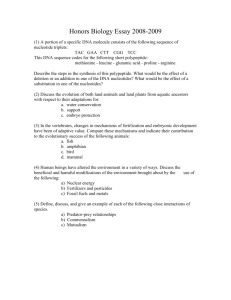
Cells ➢ Non-polar amino acids cause proteins to remain embedded in membranes=falsifies Davson-Danielli model since look at ending of phrase ➢ Be careful with magnification (make sure to convert, use correct sig. digs, check units) ➢ Surface area to volume ratio as cell grows=decreases, so rate of gas exchange is too low ➢ Lysosome has a single membrane; nucleus, mitochondria, chloroplast have double ➢ Smaller space between phospholipids + glycolipids attached to phospholipids ➢ Hypertonic=water out, hypotonic=water in (low to high solute, since high to low water) ○ Animal: lysed, normal, shrivelled ○ Plant: turgid (normal), flaccid, plasmolyzed ➢ Specific terminology ○ Structure of phospholipids=fluidity and cholesterol (temperature range) ○ Mutually beneficial for endosymbiotic theory ➢ Facilitated diffusion for polar/charged ➢ Tumour suppressor genes normally cause cell apoptosis and repair cells ➢ State=one word Molecular Biology ➢ Read questions thoroughly ○ 4 nucleotides vs. 8 ○ Some proteins have more than one polypeptide chain (genes just contribute with Central Dogma, but polypeptide chains can go together to form other proteins) ➢ Make educated guesses if unsure ○ Lipase=lipids, glycerol and fatty acids make up triglycerides ➢ Explain/annotate diagrams if you include them (Sections of pH graph, show how work) ➢ Both DNA and RNA rely on complementary base pairing, DNA in nucleus but RNA isn’t ➢ When describing hydrolysis of molecule, discuss enzyme + put over arrow in equation ➢ DNA replication: DNA polymerase attaches to the exposed bases to begin elongation on both parallel strands, moving in the 3’-5’ direction, then it facilitates the addition of complementary base pairing using the nucleotides, building 2 daughter strands in the 5’-3’ direction ○ Lagging=away from helicase, thus made in segments ➢ Pay attention to get numbers within accepted range ➢ Better graph interpretation=qualify/quantify, talk about other factors, use correct graph ➢ Use “likely” (not certain) to explain possible graph analysis ➢ DNA diagram: phosphodiester bond between nucleotides, 5’ at top left, nitrogenous bases (not nucleotides, that is the entire molecule), AT has 2 H-bonds and GC has 3 ➢ pH changes charge of enzyme, which changes the shape of the active site ➢ Careful when drawing diagrams (O in middle of maltose because water is created) Genetics ➢ Read question (mutation for sickle cell in brain cells, long chromosomes with centromere=2) ➢ Make sure to list all possible genotypes ➢ Simple answers best: “X would only supply I^B or i” instead of drawing all squares/paragraph ➢ ACGT/U are nitrogen bases NOT nucleotides ➢ Be careful with specific wording ○ “Altering single DNA base” means not deletion/insertion ➢ Word answers purposefully and state the obvious ○ Sex chromosomes control sex characteristics ➢ Hemophilia=X-linked recessive ➢ Independent assortment=metaphase I (not II) with 2^23 possibilities ➢ Not in colour (not seen when scanned for IB) ➢ Stem cells=undifferentiated ➢ Vvcc x vvCc have 1:1:1:1 ratio (not just 1, needs to produce all phenotypes) ➢ Estimated genes in human gemore=25,000 ➢ Codon=sequence of nucleotides on mRNA that correspond to an amino acid ➢ Nonsense=stop codon, Sanger technique is to sequence DNA ➢ PCR=heat breaks H-bonds, Taq polymerase attach nucleotides, ligase for phosphodiester bonds ➢ X-linked recessive=common in males, female can be carrier, female has affected father/sons Ecology ➢ Trophic level=feeding level (need space between to count as feeding, thus need 4 organisms for 3 trophic levels) ➢ Nutrients cycle between biotic and abiotic environment ➢ Use simple phrases/not necessary to what question is asking ○ “warming of atmosphere by trapping longwave radiation” ○ Specific terminology: “no statistically significant relationship” ➢ Fluctuate over time=cyclic ➢ Degree of freedom (chi-squared) is 1 for quadrats (even though 3 for genes) Evolution ➢ Terminology: “endothermic”, “prokaryote” for archaebacteria, “selective pressures” for struggle for survival”, variation due to mutations ➢ Prokaryotic=70S ribosomes, flagella is extension to cell so contains cytoplasm ➢ Read (letters for spots of dichotomous key) ➢ Organization=keep information together, give examples, bullet points ➢ Bryophyta and filicinophyta produce spores ➢ Hardy Weinberg=changes in allele frequency over time, different is evolution, snapshot of gene pool, q^2=recessive genotype and q=frequency of recessive allele (vice versa for dominant)




